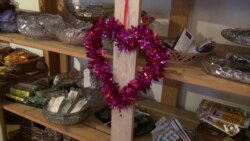For many people, there is nothing better than a piece of candy.
Sweets date back thousands of years to the ancient Egyptians, who ate sesame seeds with honey.
In the United States, a good place to learn about candy is the True Treats Historic Candy store in Harpers Ferry, West Virginia. The store sells many kinds of treats that were popular during different periods in history. The unusual collection has everything from chocolate kisses to edible bugs.
True Treats is said to be the only historic candy store in the United States. The business opened eight years ago. It has everything from ancient Greek chewing gum to favorite candies from the 1900s.
Susan Benjamin is the store’s owner. She tells people interesting facts about the 400 products found in True Treats. Many visitors enjoy reading historical information written on product labels.
Benjamin notes that sweets were first used to treat health problems.
"Sugar was used as medicine, and the Turkish delight was made for sore throats somewhere around the year 900. And it became very popular worldwide."
People also enjoyed some plants that were naturally sweet. They chewed on tree bark, branches and roots.
"In the mid-1800s, kids would go and buy a root of licorice plant and they would chew it and get that delicious licorice flavor."
One popular product at True Treats is a mix of roasted crickets and mealworms. Benjamin says these insects were once considered a sweet snack.
"The crickets, to me, taste a little bit like sesame. I've had ants, and some of them are a little bit bitter, almost tart like lemon."
Small round fruit and nut chocolate candies were popular from the 1920s to 1950s with people who played card games.
"And they made little candies that people could pick up with their fingers in one hand and hold the cards in the other."
Some visitors to True Treats find candy that brings back memories. Others are too young to have grown up with any of the candy in the store, like Bev Soriano.
"I came here a lot as a kid, so it's kind of a lot of nostalgia, which is weird because it's in such an unfamiliar setting, yet I have so many fond memories."
Benjamin has also written a book called Sweet as Sin about the history of sweet treats.
I’m Jonathan Evans.
Deborah Block reported this story for VOANews. Jonathan Evans adapted her report for Learning English. George Grow was the editor.
_______________________________________________________________
Words in This Story
bark – n. the outer covering of a tree
sesame – n. a plant that is grown in warm regions and that produces small flat seeds that are used in cooking and as a source of oil
tart – adj. having a sharp or sour taste
candy – n. a sweet food made with sugar or chocolate
edible – adj. suitable or safe to eat
label – n. a piece of paper, cloth, or similar material that is attached to something to identify or describe it
kid – n. a child
nostalgia – n. pleasure and sadness that is caused by remembering something from the past and wishing that you could experience it again
weird – adj. strange






